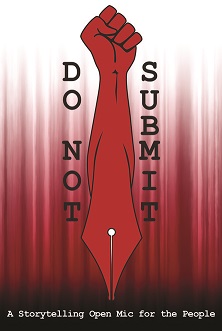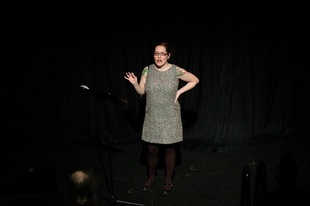| « Uncalled-for Reading Series @ Uncharted Books | Book Review: Bob Hartley's Following Tommy » |
Author Mon Aug 26 2013
Breaking into Live Lit: An Amateur's Guide
If you regularly attend live lit events in Chicago, you've probably considered contributing your own work at least once. Maybe you've been lurking in the back of the audience for years, longing to join in. Maybe you're an aspiring writer with no performance experience. Maybe you're a fan of a particular series, but just have no clue how to get involved.
If you fall into any of these categories, this guide is for you. No matter your level of experience or expertise, you can break into Chicago's live lit scene. All it takes is a little persistent effort and an intelligent use of your time. Here are some pointers.
Step #1: Find a "Home"
There are many, many live literary events in Chicago spanning a variety of topics, settings, and audiences. If you're new to the scene, it's tempting to adopt a scatter-shot approach, applying willy-nilly to any and every show you can think of. But if you're a new writer/performer, cool your jets. Focus on shows that are amenable to your own style and topics of interest.
Do you like to write personal creative essays? Story Club, Essay Fiesta, or This Much is True might be the place for you. Do you prefer to tell a story off the cuff, free of notes? Go for The Moth or Do Not Submit. Do you prefer nonfiction that covers current events or pop culture? The Paper Machete is your bag. Do you have a gritty, explicit tale to tell? Guts & Glory or The Sunday Night Sex Show are your spots. Choosing an appropriate setting for your work is absolutely essential.
Step #2: Become a Regular
Establish a rapport with the show (or shows) you'd like to submit to. Each show is its own microcosm within the live lit community, and to become a member of that community you must show your face. Hang around and chat with contributors after the show, or send the show's organizers a nice email or Facebook post.
Attend a show multiple times before submitting your work to its hosts. This will improve your chances in two ways. First, it will allow your to learn the show's unique style, and second, it will convince the show's hosts that you are a thoughtful, decent member of the live lit community (and not a foaming psychopath)-- both of which will vastly improve your odds.
Step #3: Learn the House Style
Every live lit series has its own unique style, and the only way to master the style is to attend regularly and pay close attention. Before submitting work to a series, ask yourself the following: How long is the average piece? Do contributions ever contain explicit content? Do contributors use the first person, or is it more journalistic? Do readers use notes or do they speak extemporaneously? Is work laugh-a-minute, or more subdued and serious? How irreverent are the stories? How conversational are they?
Once you have a good sense of a series' style (and what distinguishes it from other shows), you are ready to start writing. As you write your piece, never lose track of the desired tone, length, and style. The ideal submission should be a perfect amalgam of the show's overall sensibility and your own unique voice.
Step #4: Find the Appropriate Submission Channel
Live lit shows accept new work in a variety of ways. Make sure you play by a show's particular rules so you don't irritate the hosts and organizers with emails or in-person queries that don't follow the standard procedure. Usually you can find the appropriate submissions method on the series' website or on their social media pages.
Some shows, like Do Not Submit, Story Club, and The Moth run on an open-mic basis, in which case the only way to participate is to show up early, put your name in, and wait for the opportunity to share. Other shows, like Essay Fiesta, Fictlicious, and Write Club accept online submissions. In some cases, shows have dedicated open mic nights that are distinct from the main show, but give new writers the opportunity to try out material and eventually snag a spot at the main event. For example, The Paper Machete, runs an open-mic writing group the first Wednesday of every month that occasionally feeds new writers into the main show. 
Step #5: Be Not Afraid!
Even if you carefully study the show you are submitting to, attend it often, schmooze with the hosts, and craft a piece you are utterly happy with, you might face disappointment. Before you swear off live lit entirely, remember that work is rejected for all kinds of reasons. Maybe your story wasn't appropriate for the venue or the event. Maybe the hosts have a big backlog of performers on their schedule. Maybe you're close to the appropriate style or tone, but haven't quite perfected it.
A rejection does not mean that your writing is terrible or that the hosts dislike you. Try again! Almost no one gets a story into a show the first time they try. Learning to respond to criticism or rejection is a crucial stage of development as a writer or a performer.
Anecdote in point: Earlier this summer, I sent a few samples to Karen and Willy at Essay Fiesta. At first they gave me the kindest, most encouraging rejection ever. The pieces I sent just weren't right, but they were close, and I was encouraged to submit again. I spent more time editing some other work and attending Essay Fiesta, then I submitted two more pieces a few months later and got into the show. I'm sure most writers have had similar experiences with live lit shows (or lit mags). Tenacity and sensitivity to criticism can really pay off in both cases!
Step #6: Do it! Now!
There you have it! You now have the tools to begin a foray into live lit. Actually, you probably had all of these tools before you even clicked on this piece. If you're an avid attendee of lit events in Chicago, you already know a great deal about what works and what doesn't in live storytelling. So use your knowledge, write a piece, and take it out on the town.
Photo of Larry Kerns at This Much is True by Jill Howe is courtesy of the This Much is True website.
Photo of JH Palmer at a recent Story Club event by Jill Howe courtesy of Story Club's website.
Do Not Submit postcard image is courtesy of Do Not Submit's website.












Dee / August 26, 2013 1:04 PM
Don't forget The Button Down storytelling series!